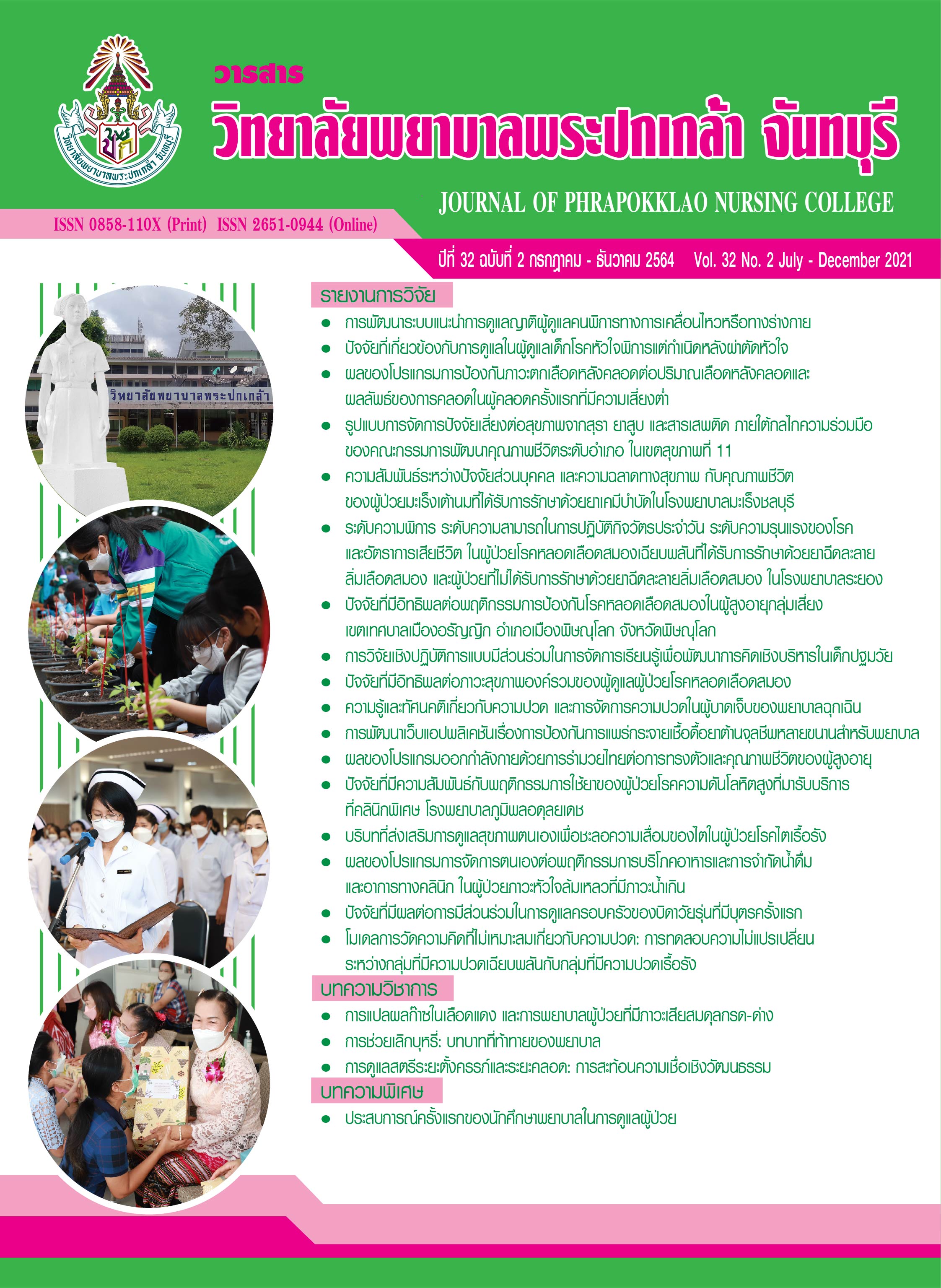ผลของโปรแกรมการจัดการตนเองต่อพฤติกรรมการบริโภคอาหารและการจำกัดน้ำดื่ม และอาการทางคลินิก ในผู้ป่วยภาวะหัวใจล้มเหลวที่มีภาวะน้ำเกิน
คำสำคัญ:
โปรแกรมการจัดการตนเอง, พฤติกรรมการบริโภคอาหารและการจำกัดน้ำดื่ม, อาการทางคลินิก, ผู้ป่วยภาวะหัวใจล้มเหลวที่มีภาวะน้ำเกินบทคัดย่อ
การวิจัยครั้งนี้เป็นการวิจัยกึ่งทดลอง เพื่อศึกษาผลของโปรแกรมการจัดการตนเองต่อพฤติกรรมการบริโภคอาหารและการจำกัดน้ำดื่ม และอาการทางคลินิก ในผู้ป่วยภาวะหัวใจล้มเหลวที่มีภาวะน้ำเกิน กลุ่มตัวอย่างเป็นผู้ป่วยภาวะหัวใจล้มเหลวที่มีภาวะน้ำเกิน ที่เข้ารับการรักษาในโรงพยาบาลเลิดสิน จำนวน 40 คน แบ่งออกเป็นกลุ่มทดลองและกลุ่มควบคุม กลุ่มละ 20 คน เครื่องมือการวิจัยประกอบด้วย โปรแกรมการจัดการตนเอง แบบสัมภาษณ์ข้อมูลส่วนบุคคลของผู้ป่วย แบบสัมภาษณ์ข้อมูลส่วนบุคคลของสมาชิกในครอบครัว แบบสัมภาษณ์พฤติกรรมการบริโภคอาหารและการจำกัดน้ำดื่ม มีค่าความเชื่อมั่น .78 และ แบบสัมภาษณ์การรับรู้อาการทางคลินิกของภาวะหัวใจล้มเหลว มีค่าความเชื่อมั่น .88 ดำเนินการทดลองและเก็บรวบรวมข้อมูลในช่วงเดือนกุมภาพันธ์ถึงเดือนกรกฎาคม 2564 วิเคราะห์ข้อมูลด้วยสถิติความถี่ ร้อยละ Chi-square test, Fisher’s exact test, paired t-test และ ANCOVA
ผลการวิจัยพบว่า 1) หลังการทดลอง กลุ่มทดลองมีคะแนนเฉลี่ยพฤติกรรมการบริโภคอาหารและการจำกัดน้ำดื่มสูงกว่าก่อนการทดลองอย่างมีนัยสำคัญทางสถิติ (t = 10.625, p < .001) และสูงกว่ากลุ่มควบคุมอย่างมีนัยสำคัญทางสถิติ (F = 160.150, p < .001) และ 2) หลังการทดลอง กลุ่มทดลองมีคะแนนเฉลี่ยอาการทางคลินิกต่ำกว่าก่อนการทดลองอย่างมีนัยสำคัญทางสถิติ (t = 16.084, p < .001) และต่ำกว่ากลุ่มควบคุมอย่างมีนัยสำคัญทางสถิติ (F = 22.870, p < .001)
จากการวิจัยครั้งนี้มีข้อเสนอแนะว่า บุคลากรทางสุขภาพควรนำโปรแกรมการจัดการตนเองไปใช้ในการพัฒนาคุณภาพการดูแลผู้ป่วยภาวะหัวใจล้มเหลว โดยส่งเสริมให้ผู้ป่วยและสมาชิกในครอบครัวร่วมกันวางแผนการจัดการตนเองอย่างเหมาะสม เพื่อป้องกันการเกิดภาวะน้ำเกิน และควบคุมอาการของโรคได้
เอกสารอ้างอิง
จิราภรณ์ มีชูสิน, อาภรณ์ ดีนาน, และศิริวัลห์ วัฒนสินธุ์. (2553). ปัจจัยที่มีความสัมพันธ์กับการรับรู้ความรุนแรงของภาวะหัวใจวายของผู้ป่วยภาวะหัวใจวาย. วารสารคณะพยาบาลศาสตร์ มหาวิทยาลัย บูรพา, 18(2), 19–33.
ชานนท์ มหารักษ์. (2562). อัตราตายและอัตราการเข้ารักษาซํ้าของผู้ป่วยภาวะหัวใจล้มเหลวในโรงพยาบาลพังงา. วารสารวิชาการแพทย์ เขต 11, 33(2), 311–326.
ณัฐรพี ใจงาม, อรนุช ชูศรี, รุ่งนภา ป้องเกียรติชัย, และรังสรรค์ มาระเพ็ญ. (2560). แนวคิดการจัดการภาวะสุขภาพของบุคคลและครอบครัวที่มีสมาชิกป่วยด้วยโรคเรื้อรัง. วารสารพยาบาลกระทรวงสาธารณสุข, 27(3), 1–9.
สว่างจิต คงภิบาล, นรลักขณ์ เอื้อกิจ, และปชาณัฏฐ์ ตันติโกสุม. (2560). ผลของโปรแกรมการจัดการตนเองต่อพฤติกรรมการบริโภคอาหารของผู้ป่วยที่มีภาวะหัวใจล้มเหลว. วารสารพยาบาลโรคหัวใจและทรวงอก, 28(2), 82–96.
อัจษรา บุญมีศรีทรัพย์, อาภรณ์ ดีนาน, และกนกนุช ชื่นเลิศสกุล. (2552). ปัจจัยทำนายพฤติกรรมการรับประทานอาหารเฉพาะโรคของผู้ป่วยโรคหลอดเลือดหัวใจ. วารสารคณะพยาบาลศาสตร์ มหาวิทยาลัยบูรพา, 17(3), 41–53.
Audthiya, P., Pothiban, L., Panuthai, S., & Chintanawat, R. (2021). Enhancing autonomy and self-management behaviors through a patient-centered communication program for older adults with hypertension: A randomized controlled trial. Pacific Rim International Journal of Nursing Research, 25(4), 525–538. Retrieved from https://he02.tci-thaijo.org/index.php/PRIJNR/article/view/253312/172226
Bragazzi, N. L., Zhong, W., Shu, J., Abu Much, A., Lotan, D., Grupper, A., ... & Dai, H. (2021). Burden of heart failure and underlying causes in 195 countries and territories from 1990 to 2017. European Journal of Preventive Cardiology. Retrieved from https://academic.oup.com/eurjpc/advance-article/doi/10.1093/eurjpc/zwaa147/6133248
Cook, J., & Horrocks, S. (2015). Evaluation of a heart failure self-management programme. British Journal of Cardiac Nursing, 10(12), 603–608. doi:10.12968/bjca.2015.10.12.603
Dianati, M., Asmaroud, S. R., Shafaghi, S., & Naghashzadeh, F. (2020). Effects of an empowerment program on self-care behaviors and readmission of patients with heart failure: A randomized clinical trial. Tanaffos, 19(4), 312–321. Retrieved from https://pubmed.ncbi.nlm.nih.gov/33959168/
Faul, F. (2020). G*Power version 3.1.9.6. Retrieved from http://www.psychologie.hhu.de/arbeitsgruppen/allgemeine-psychologieundarbeitspsychologie/gpower.htm
Jaarsma, T., Hill, L., Bayes-Genis, A., La Rocca, H.-P. B., Castiello, T., Celutkiene, J., … & Stromberg, A. (2021). Self-care of heart failure patients: Practical management recommendations from the Heart Failure Association of the European Society of Cardiology. European Journal of Heart Failure, 23(1), 157–174. doi:10.1002/ejhf.2008
Jaarsma, T., Stromberg, A., Gal, T. B., Cameron, J., Driscoll, A., Duengen, H.-D., … Riegel, B. (2013). Comparison of self-care behaviors of heart failure patients in 15 countries worldwide. Patient Education and Counseling, 92(1), 114–120. doi:10.1016/j.pec.2013.02.017
Jonkman, N. H., Westland, H., Groenwold, R. H., Agren, S., Anguita, M., Blue, L., … Hoes, A. W. (2016). What are effective program characteristics of self-management interventions in patients with heart failure? An individual patient data meta-analysis. Journal of Cardiac Failure, 22(11), 861–871. doi:10.1016/j.cardfail.2016.06.422
Lee, C. S., Bidwell, J. T., Paturzo, M., Alvaro, R., Cocchieri, A., Jaarsma, T., … Vellone, E. (2018). Patterns of self-care and clinical events in a cohort of adults with heart failure: 1 year follow-up. Heart & Lung, 47(1), 40–46. doi:10.1016/j.hrtlng.2017.09.004
Reyes, E. B., Ha, J.-W., Firdaus, I., Ghazi, A. M., Phrommintikul, A., Sim, D., … Cowie, M. R. (2016). Heart failure across Asia: Same healthcare burden but differences in organization of care. International Journal of Cardiology, 223, 163–167. doi:10.1016/j.ijcard.2016.07.256
Ryan, P., & Sawin, K. J. (2009). The Individual and Family Self-Management Theory: Background and perspectives on context, process, and outcomes. Nursing Outlook, 57(4), 217–225. doi:10.1016/j.outlook.2008.10.004
Seid, M. A., Abdela, O. A., & Zeleke, E. G. (2019). Adherence to self-care recommendations and associated factors among adult heart failure patients. From the patients’ point of view. PLoS One, 14(2), e0211768. doi:10.1371/journal.pone.0211768
Somsiri, V., Asdornwised, U., O’Connor, M., Suwanugsorn, S., & Chansatitporn, N. (2020). Effects of a transitional telehealth program on functional status, rehospitalization, and satisfaction with care in Thai patients with heart failure. Home Health Care Management & Practice, 33(9), 72–80. doi:10.1177/1084822320969400
Sun, J., Zhang, Z.-W., Ma, Y.-X., Liu, W., & Wang, C.-Y. (2019). Application of self-care based on full- course individualized health education in patients with chronic heart failure and its influencing factors. World Journal of Clinical Cases, 7(16), 2165–2175. doi:10.12998/wjcc.v7.i16.2165
Tankumpuan, T., Asano, R., Koirala, B., Dennison-Himmelfarb, C., Sindhu, S., & Davidson, P. M. (2019). Heart failure and social determinants of health in Thailand: An integrative review. Heliyon, 5(5), e01658. Retrieved from https://www.sciencedirect.com/science/article/pii/S2405844018354744
Tawalbeh, L. I., Al Qadire, M., Ahmad, M. M., Aloush, S., Abu Sumaqa, Y., & Halabi, M. (2017). Knowledge and self-care behaviors among patients with heart failure in Jordan. Research in Nursing & Health, 40(4), 350–359. doi:10.1002/nur.21805
Tawalbeh, L. I., Al-Smadi, A. M., AlBashtawy, M., AlJezawi, M., Jarrah, M., Musa, A. S., & Aloush, S. (2020). The most and the least performed self-care behaviors among patients with heart failure in Jordan. Clinical Nursing Research, 29(2), 108–116. doi:10.1177/1054773818779492
Thibodeau, J. T., & Drazner, M. H. (2018). The role of the clinical examination in patients with heart failure. JACC: Heart Failure, 6(7), 543–551. doi:10.1016/j.jchf.2018.04.005
Yancy, C. W., Jessup, M., Bozkurt, B., Butler, J., Casey Jr, D. E., Drazner, M. H., ... Wilkoff, B. L. (2013). 2013 ACCF/AHA guideline for the management of heart failure: Executive summary: A report of the American College of Cardiology Foundation/American Heart Association Task Force on practice guidelines. Circulation, 128(16), 1810–1852. doi:10.1161/CIR.0b013e31829e8807
Yingchoncharoen, T., Wu, T. C., Choi, D. J., Ong, T. K., Liew, H. B., & Cho, M. C. (2021). Economic burden of heart failure in Asian countries with different healthcare systems. Korean Circulation Journal, 51(8), 681–693. doi:10.4070/kcj.2021.0029
ดาวน์โหลด
เผยแพร่แล้ว
รูปแบบการอ้างอิง
ฉบับ
ประเภทบทความ
สัญญาอนุญาต
ลิขสิทธิ์ (c) 2021 วารสารวิทยาลัยพยาบาลพระปกเกล้า จันทบุรี

อนุญาตภายใต้เงื่อนไข Creative Commons Attribution-NonCommercial-NoDerivatives 4.0 International License.
เนื้อความ ข้อมูล และรายการอ้างอิงที่ผู้เขียนใช้ในการเขียนบทความเพื่อลงตีพิมพ์ในวารสารวิทยาลัยพยาบาลพระปกเกล้า จันทบุรี ถือเป็นความคิดเห็นและความรับผิดชอบของผู้เขียน คณะผู้จัดทำวารสารไม่จำเป็นต้องเห็นพ้องด้วยหรือร่วมรับผิดชอบ
บทความที่ได้รับการลงตีพิมพ์ในวารสารวิทยาลัยพยาบาลพระปกเกล้า จันทบุรี ถือเป็นลิขสิทธิ์ของวารสารวิทยาลัยพยาบาลพระปกเกล้า จันทบุรี หากหน่วยงานหรือบุคคลใดต้องการนำส่วนหนึ่งหรือทั้งหมดของบทความไปเผยแพร่ต่อเพื่อวัตถุประสงค์ใด ๆ จะต้องได้รับอนุญาตจากบรรณาธิการวารสารก่อน



